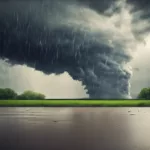17 December 2023
Examining the Link Between Climate Change and Increasingly Severe Storms
In recent years, the world has witnessed a surge in extreme weather events, from devastating hurricanes to unprecedented heatwaves. As scientists and experts continue to study the causes and effects of these phenomena, a growing body of evidence points to the role of climate change in exacerbating their intensity and frequency. This article delves into the connection between climate change and extreme weather events, exploring the scientific research, real-life examples, and expert insights that shed light on this pressing issue.
The Science Behind Climate Change and Extreme Weather
Climate change is primarily driven by the increase in greenhouse gas emissions, particularly carbon dioxide, resulting from human activities such as burning fossil fuels and deforestation. These greenhouse gases trap heat in the Earth’s atmosphere, leading to a rise in global temperatures. This warming effect disrupts weather patterns and contributes to the occurrence of extreme weather events.
Hurricanes and Rising Sea Levels
One of the most visible manifestations of climate change is the intensification of hurricanes. Warmer ocean temperatures provide the energy needed for hurricanes to form and strengthen. Additionally, rising sea levels due to melting ice caps and thermal expansion increase the likelihood of storm surges, amplifying the destructive power of hurricanes. The devastating impacts of Hurricane Katrina in 2005 and Hurricane Harvey in 2017 serve as stark reminders of the destructive potential of these storms.
Heatwaves and Droughts
Heatwaves have become more frequent and prolonged in many parts of the world, resulting in severe health risks and agricultural challenges. Climate change exacerbates heatwaves by trapping heat in the atmosphere and disrupting natural weather patterns. Similarly, droughts are becoming more severe and prolonged, with devastating consequences for agriculture, water supply, and ecosystems. California’s recent drought, which lasted for several years, serves as a poignant example of the impact of climate change on water scarcity.
Wildfires and Climate Change
The link between climate change and wildfires is particularly evident in regions prone to dry and hot conditions. Rising temperatures and prolonged droughts create ideal conditions for wildfires to spread rapidly and become more intense. The devastating wildfires that ravaged Australia in 2019-2020 and the western United States in recent years highlight the destructive synergy between climate change and wildfires.
Extreme Rainfall and Flooding
Climate change also contributes to extreme rainfall events, leading to flash floods and river flooding. Warmer air holds more moisture, increasing the potential for heavy downpours. This increased precipitation, combined with changes in atmospheric circulation patterns, can result in catastrophic flooding. The devastating floods in Houston, Texas in 2017 and the recent flooding in Germany and Belgium are stark reminders of the destructive power of extreme rainfall events.
Conclusion:
As extreme weather events become more frequent and severe, it is crucial to address the underlying causes and take action to mitigate the impacts of climate change. The scientific consensus is clear: human activities are driving climate change, and urgent measures are needed to reduce greenhouse gas emissions and transition to clean energy sources. By understanding the connection between climate change and extreme weather events, we can better prepare for the challenges ahead and work towards a more sustainable and resilient future.



